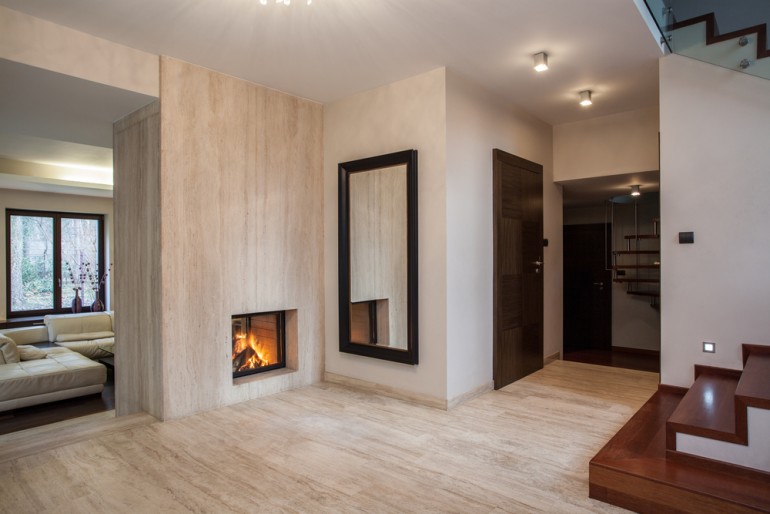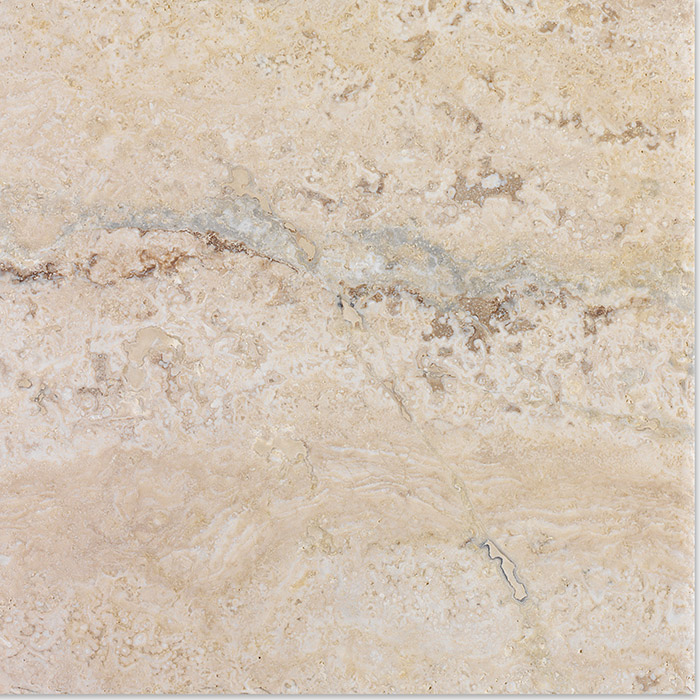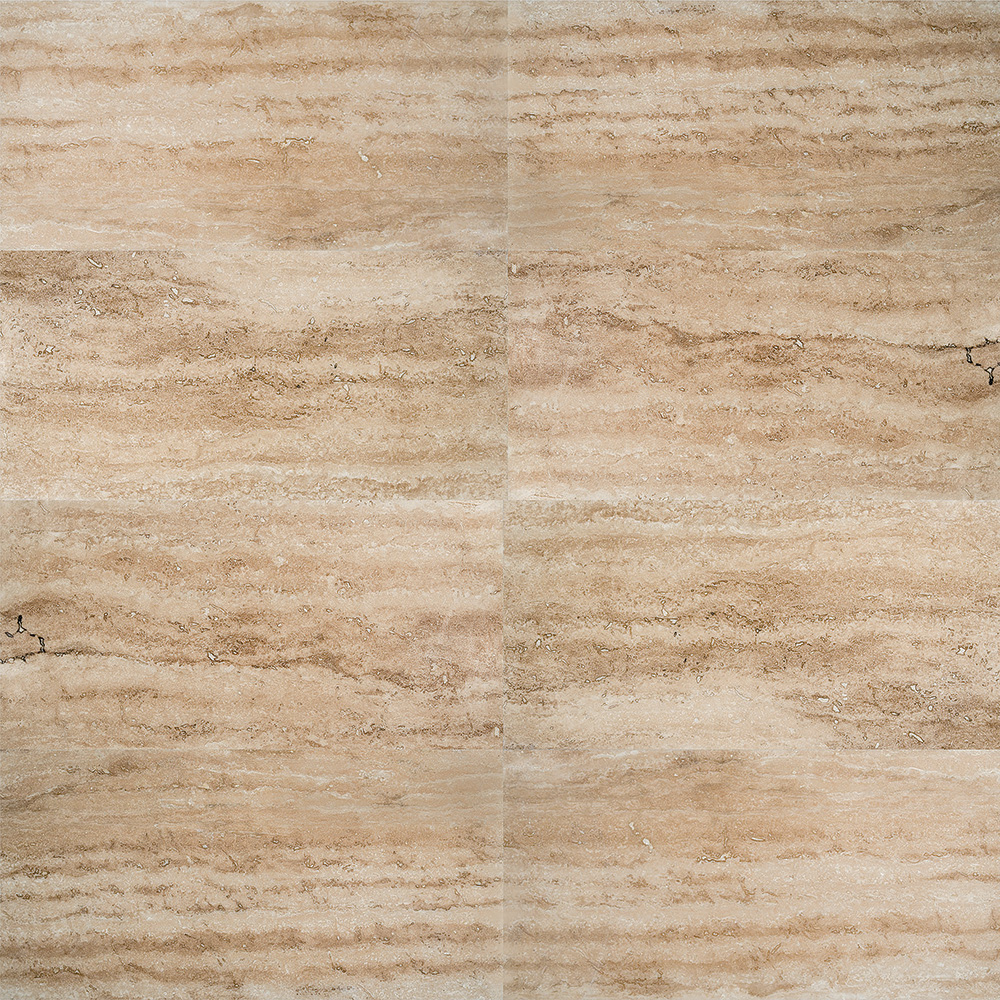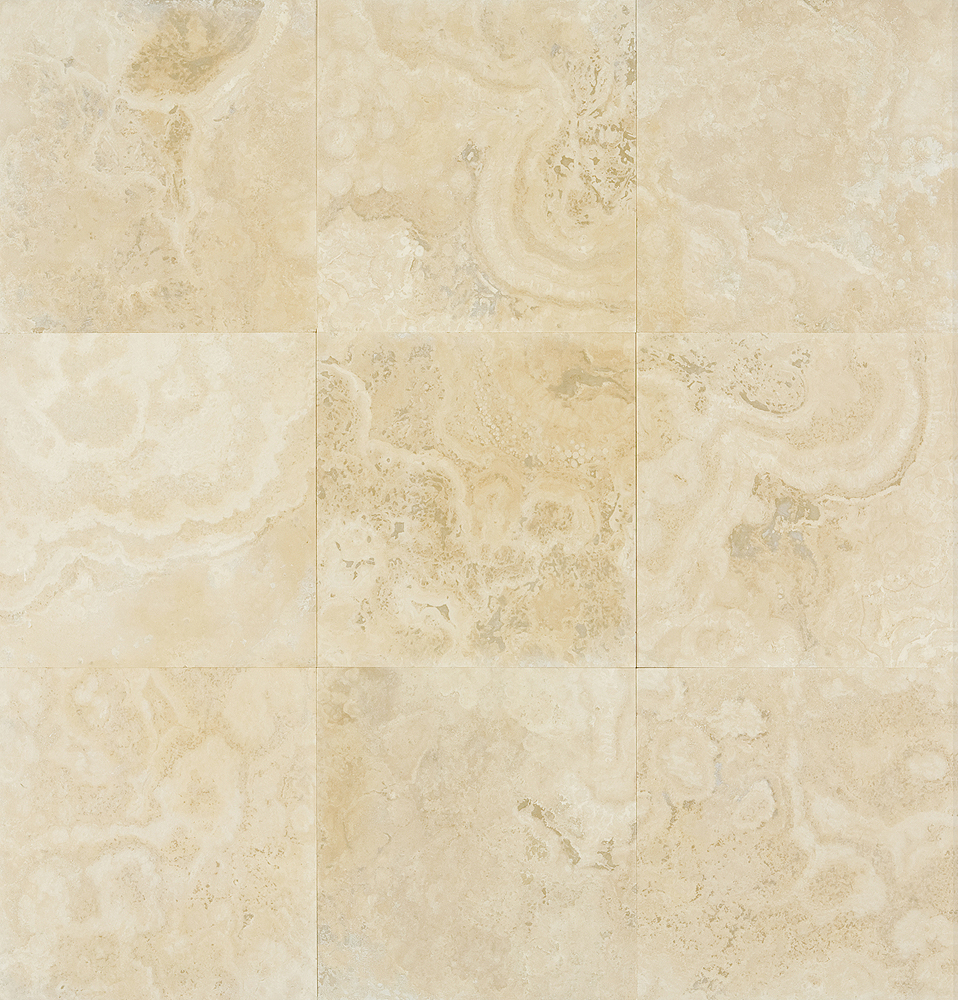Types and Grades of Travertine Tile
Before purchasing your travertine tile, it is important to become familiar with industry terms in order to choose the type and grade of tile most appropriate for your purposes. While there is no industry standard name for the grades of travertine, most establishments use the names listed below. The two types of travertine tiles are created by using different cutting methods, not by using different types of travertine stone.
Travertine Grades
There are three grades of travertine: premium, standard, and commercial. Premium grade, which is sometimes called first grade, is a tile that has been perfectly cut and has a uniform thickness throughout with very little filler. Standard grade, also called second grade, will also be perfectly cut with a uniform thickness, however, there will be a bit more filler in the stone. Commercial grade, also known as third grade, may not be perfectly cut on all sides and it will not have a uniform thickness. Additionally, there will be a great deal more filler within the stone.
Premium or First Grade
- This grade offers the greatest selection of colors free from black or gray discoloration in the travertine tiles.
- The travertine tiles are carefully chosen to be consistent in color.
- The tiles are double filled, first, by machinery and then by hand if any holes remain.
- None of the travertine tiles of this grade will have large holes that were filled.
- The edges of the tiles are smooth and evenly sized with uniform beveled edges.
Standard or Second Grade
- This grade offers the second largest selection of travertine tile colors free from gray or black discoloration.
- The travertine tiles are carefully chosen to have a consistent color throughout the lot.
- Tiles are double filled as in the premium grade.
- Some large holes are allowed in standard grade travertine tiles. Additionally, some holes may be filled through the full thickness of the tile.
- The color may contain some striations or swirls.
- The edges of the tiles are smooth and evenly sized with uniform beveled edges.
Commercial or Third Grade
- Large color variations are allowed within the tile including gray or black markings.
- Small unfilled holes are allowed as are small defects in sizing and honing.
- The tiles are not hand filled.
- It is acceptable for large voids to be filled.
- Small holes that run from the surface to the bottom of the tile are allowed.
- Edges may be cracked or broken.
- Tiles may be delivered without color selection or sorting.
Travertine Types
Cut Types
Due to the bedding planes inherent in most travertine, it is possible to achieve a dramatically different look depending on the cut type chosen. The two cut types used to create travertine tiles are the Vein Cut and the Fleuri Cut. The travertine itself is the same for both types of tile; it is only the type of cut that causes the stone to differ in appearance.
Vein Cut
Vein cut describes the cutting process by which a cut is made against the bedding planes, or along the vein. This exposes the edge of the formation and gives the travertine tile a linear pattern.
Fleuri Cut
Fleuri cut, which is also known as a cross cut, is a cut made parallel to the bedding plane. This exposes a random pattern that is often circular. This cut does result in a strong tile; however, it is not ideal for high-traffic areas due to holes that may appear with heavy use. After installation, if holes should appear, it is standard practice to fill those holes instead of replacing the tile.
What criteria indicates good quality travertine tile?
- All four corners of the tile should be cut at 90 degrees.
- The color of the stone should not be marred my rust colored markings on either side.
- There should be no pores in the filling of the stone.
- The filling should consist of a hard resin that will not chip; cement is unacceptable.
- The side cuts should be perfectly perpendicular; a slope is unacceptable.
- The color of the tile should be consistent throughout the lot with limited color variations.
- The thickness of the tile should be measured in inches and should be 18” x 18”.
- The shipping crates should be strong wooden pallets suitable for forklifts.
- The face of the tile should be visible from both sides of the shipping crates.
- Styrofoam should be used on the bottom and sides of the tiles for protection.
For more information on grade and standards of marble and travertine tile please visit the Marble Institute of America: Industry Resources Page
If you’re looking for a wide selection of types and grades of travertine tile, visit BuildDirect and have a look around.






Joanne Canevet
We are having a new house built and went to a tile company recommended by the builder. We picked out Travertine for the bathrooms. In our previous house, we had Travertine installed in the master bath and absolutely loved it. It was beautiful! We thought we picked out the same Travertine for our new house. It definitely looked the same in the showroom. When I’m looking at the walls in the bathrooms, I see huge places where grout was put in the middle of the tiles. Apparently there were holes in the tiles. It looks horrible seeing these huge patches of grout. I told the builder and he said the grout has to be there so no water enters the holes and he said he should know because he’s been a builder for 40 years. I have seen Travertine in many, many, many bathrooms and have never seen grout in the tiles. I never had it in my previous house. The only thing that was grouted was in between the tiles. I also asked that the tile be sealed twice and received a lot of flack saying it will cost more for a second coat. I had two coats on the Travertine in my previous house and had no problems with the Travertine at all. I need some expert advice from someone else. I’m so upset with the tile guy the builder hired and the builder. I want the bathrooms to look rich and beautiful not with huge patches all over.
BuildDirect Product Expert Team
Hi Joanne,
Thank you for getting in touch! I’m so sorry to hear about the experience you’ve been having with your Travertine tile. Tilers do usually fill the holes in Travertine with thinset so water doesn’t get in there. You may have ended up with a lower grade Travertine than your last home which would mean the tiler would have had to fill more holes than before. The lower the grade the more holes and color variation there will be. At this point the only option may be to take it down and put up a new Travertine unfortunately. You may want to look into a different tiler and get another opinion on what they think would be the best option. Sorry we couldn’t be of more help! Please let us know if you have any other questions!
Thomas Marion
hi I am a professional tile layer. I absolutely agree with you. when I first started this trade I had never layed any kind of tile. my first job was a huge travertine wall. it had random holes and pits some small and far from each other. others large and covering most of the stone. we layed the wall and made the decision to not grout the tile at all. yes if your doing a floor or countertop there is the possibility that water can fill these holes and cause odder or damage but in my experience as long as you clean moderately u are fine,and it will last a lifetime. even though adding grout in these voids is the industry standard I think it just looks lazy and cheap. in fact of the 3 grades of travertine the 3ed grade ( considered to be low quality ) is the best looking becouse its obvious that it is real stone. if u have any questions send me an email at blackhole18813@gmail.com
TP
We are interested in buying a home in which the entire main level has travertine floors. Nearly 10% of the tiles are cracked and we have been told “this should be expected in a 3 year old home”. There are no cracks in the walls that would indicate any major shifting of the foundation and the same crack will run along several tiles. There is also travertine on the Lower level with no cracks. Can you please weigh in? Thank you for any advice you can give.
BuildDirect Product Expert Team
Hi TP,
Thank you for getting in touch with BuildDirect!
Unfortunately it is not very common to see Travertine crack in a three year old home let alone a home that is much older if it has been installed properly, Travertine is a very hard stone. There could be quite a few different things happening with this floor. If it was installed over a concrete sub floor without an anti-fracture membrane it’s possible any cracks in the sub floor have transferred through to the tile. Since the crack runs through several tiles in a row this seems the most likely scenario. Even if the tile was installed over a plywood sub floor cracking would occur is the proper underlay was not installed.
There are so many different things that could be the issue in this instance. I would definitely suggest getting a inspection of the home before buying to check on why the cracking is there.
Please don’t hesitate to get in touch if there is anything else we can help out with!
Jackie mente
We are looking for outdoor flooring for our courtyard in our new restaurant. It measures 32×25. We are on a tight budget and are contracting this ourselves.
We really need some ideas. Don’t want concrete
We want this to be inviting for people to sip drinks and eat in this courtyard and different than any where else.
Would travertine be a good choice
Please Help
BuildDirect Product Expert Team
Hi Jackie,
Congratulations on the new restaurant!
Travertine will work great but have you considered using porcelain? Here are four reasons why it might be a good choice for you:
1. It’s hard-wearing – a harder material than most ceramics, being baked at higher temperatures in the kiln.
2. It’s completely water-proof – unglazed porcelain tiles are perfect for an outdoor installation.
3. It’s hygienic – bacteria does not find easy purchase on porcelain tile — another great reason to put them in a restaurant.
4. It’s affordable – premium quality, at the lowest possible pricing.
Order some of our free samples online!
Pingback: Understanding Natural Stone | Wellington Tile Warehouse
Asha patel
I am in need of replacing 1400 sq feet of ceramic tile and I feel in love with tavertine tile in franch pattern, have a mix feeling as some people have told me it require high maintanance and what will be your opinion. If I buy good grade will it help me better in heavy traffic area including kitchen where I cook and it has tendensy to get dirty on the floor. I thank you for your advise. should I be careful where I purchase my tavertine and what I should expect to pay for it per sq feet.
Eric Sweiss
I need advice on a completed job as to what rights i have if i was ripped off by the quality travertine.
Robert Di Cola
Considering using travertine for my main outdoor entrance way. I live in Arizona and wonder about how it woukd stand up to foot traffic with all the sand that would be under foot. Installation would be over a concrete slab, with a base to raise it about 2-21/2″ above the slab. How much effort in maintaning so staining would not be a problem? Thank you for your attention to this matter.
Mo Dhukka
I am having Travertine tiles put in my house, and i was reading the difference between standard and premium. I got premium tiles, but some of them have a few fillers. Is it possible that if it comes from the manufacturer some can have a few fillers since it is a natural stone? Is it possible I can send pictures of the tiles for you to view and judge?
mattie
I am going to have a flooring company install travertine using float method in my kitchen, family rm, hallways, bath rm, 2small closets and laundry room. The installer states that we don’t need to remove the linolium floor in my kitchen. Is this ok? I would really prefer to remove it. Please advise.
Mike
Need Help!
Had a boat load of travertine installed around my in ground pool. My problem is that I have had
quite a few tiles have pieces popping off the face of the tiles. I believe that I may have poor
grade tiles. Does anyone have experience with this problem. I have replaced about 65 tiles.
Now I will need another 15-20 more. I was told that this should not happen. Paid alot for this!
Jane Flagg
Does the thickness of a 24″ X 24″ matter. I thought I was buying a 5/8″ inch and was sent a 1/2″ instead.
kathy karch
we bought a new home about 6 years ago. the tile on the floor was called Noce Arizona tile. It is a kind of traverstone I am pretty sure. There seems to be quite a few different shades of the color in each tile. We are wanting to finsih more of the house in it but are having a hard time finding it. do you have any idea
Andrew
i would also like to know who the vendors are who provide non cement filled travertine and the location that they are mining from
Andrew
I have a few questions regarding your info. such as, doesn’t the resin fill have a tendency to yellow over time. I am a retailer and have been carrying Travertine for quite a while. cement fill is the most common across the industry. Resin is available but is usually quite a bit more costly overall. Also, there are some travertine colors and styles that have a very wide color variation. This contradicts some of the info that you posted. please explain.
Harry
Can someone help me with, why there would be this much difference between these 2 pieces.
Emser 12″W x 12″L Natural Travertine @ $26.77 per
and
Emser 16 x 16 Dore Antique Travertine Tile @ 7.56 per
Thanks in advance for your help.
Renata Marciniak
Hi, Rob.
Would you please tell me what are the differences or similarities between tumbled and brushed travertine?
Chad Meyer
Rob,
Good article. I am in need of the standards (ansi/astm or whatever) for the installation of stone flooring on thin-set and/or Dry-Set Portland Cement Mortar as it pertains to coverage. Is it 80%? I have ansi A108/A118/A136.1 and can only find specific info for ceramic tile.
Can you help me.
Chad Meyer
Rob Woods
Hi Bill, You make a good point. This article was written mainly for a do-it-yourselfer who likely isn’t going to get as much value from something as technical as the ANSI and ASTM standards. I’d have liked to have used some of the MIA stuff but it isn’t really available to the public without a membership. I have added a link to the MIA page where people can find all of the resources you mention above. We hope you found some value in some of the other travertine content. Thanks for the feedback. It’s definitely appreciated and please feel free to let us know if you see other areas that could use some better information.
Bill Kopperud
This is good information. However, I would like to see reference to Industry Standards (e.g. ASTM, ANSI, MIA, etc.) whenever possible.
Pingback: About Travertine Tile